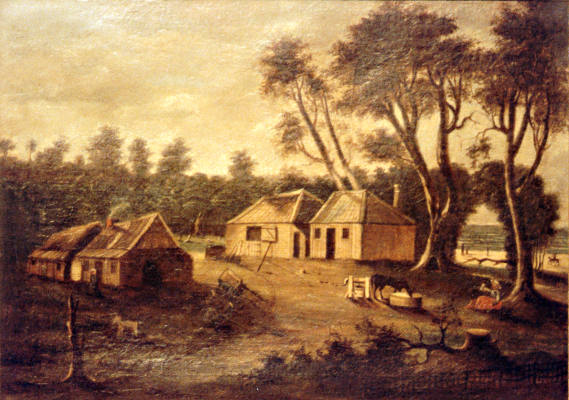1835 Squatters’ Time

Alexander MacDonald’s Homestead at Mordialloc, c1865.
The squatting Age at Port Phillip began when Batman’s and Fawkner’s parties arrived with their stock from Van Dieman’s Land.
Cattle, sheep and horses gradually covered the new grazing grounds. The first squatters near the Mordialloc Creek were Major James Fraser and Daniel MacKinnon who were granted a licence to run cattle at “Brittania Bay”, Mordialloc, in 1839. MacKinnon who had arrived that year by the ship “Caledonia”, the first vessel to sail direct from Scotland to Port Phillip, remained with Fraser only nine months before selling his share of the 200 head of cattle run on 5120 acres to David Hicksher. He then moved to the Camperdown District to join his uncle, Dr Curdie, who had overlanded cattle from Sydney. Daniel Mackinnon was for many years President of the Hampden Shire Council, in the Western District while his brother represented Prahran, in State Parliament.
Through bad seasons and other misfortunes Fraser and Hicksher relinquished their licence in 1843, but it seems that Major Fraser was still there when Richard Howitt, writer, poet and long distance walker, strode through the area on his walk to Cape Schanck and Western part, on December 29, 1843 an account of his walk was recorded in his book: “Impressions of Australia Felix”, published in London, 1845.
He wrote: “From Brighton to Major Fraser’s Squatting Station is eight or nine miles through the sandy bush, thinly wooded with wild cherry, banksia, she and forest oaks, and with three kinds of eucalyptus trees.” Then when he reached the present Mentone: “Now I approached a blue opening of the bay, and on emerging from the denser to the thinner bush, a few miles before reaching Fraser’s location, the roll of some kind of carriage was close behind me. It soon overtook and passed me, light as an American wagon; was drawn by two horse full of holiday looking people, who I concluded, were, it being the festive week of Christmas, going to some kind of merrymaking at the Travellers’ Home”, a rural inn a little further on, kept by David Calderwell; a place fortified within with store of good wine, and without, a bold demonstration of inward doings, with empty bottles, the house being almost buried in them, piles upon piles.
He then tells of his arrival at Mordialloc; “I had left the country of running water, and its music, the song of the bell-bird. I entered a cottage to furnish myself with a bottle of the scarce element, to make inquiries along my way etc., and there learnt that the persons whom I had passed on the road, or rather who had in the first instance, passed me, were Sir John Franklin, his lady, and their party. (The light carriage had broken down on the rough bush track, we now know as Nepean Highway).
I had now, through the simple and homely direction of the cottage folk, to turn back to the bay, and there to wade through a salt water creek, more readily to be crossed there , as it deepened and spread wider inland.”
Major Fraser, who had served in the capture of Java and the campaign at Flanders, became Superintendent of one of the penal establishments at Van Dieman’s Land. His son, Charles Forbes Fraser, who was born at Melbourne at the time his father was squatting at Mordialloc, later returned to Victoria, bred several well known racehorses and was V.R.C., stipendiary Steward for many years. One of his horses, Sir William, finished second to Malvolio in the Melbourne Cup of 1891.
The next to try his luck at Mordialloc was Alexander McDonald, (or MacDonald), who had far more success than his predecessors. He had arrived in Sydney in 1838 but left soon afterwards for Port Phillip where he was a partner with his brother in a sheep run, presumably the “Point Nepean:” because that licence was in his name from 1839 to 1841. He married and took up another run on the Yarra, “Stringy Bark”, in 1841, but two years later sold out.
The licence for the “Mordiallack” No2 run was registered in the name of Alexander McDonald 1842-51, and according to A S Kenyon, he held the “Traveller’s Rest” in 1841. Whether the “Traveller’s Rest” and the “Traveller’s Home”, were one and the same, is difficult to determine. However history has shown that McDonald had a flare for inn keeping and built the Mordialloc Hotel in 1853, when he obtained a land grant of 450 acres, a property still in the possession of the family when he died in 1881. He ran the hotel until April 1859.
McDonald conducted the “Mordiallac”, run in partnership with “Hunter” 1842-1851, and with “Ballingall” 1850-51, and transferred his squatting rights to Adolphus Frazer on April 4, 1860. This was the land he hadn’t purchased through his pre-emptive rights.
